by Eric
When it comes to personal defense, it’s very hard to argue with a handgun being the best choice. Often the mere sight of a handgun will send a potential assailant fleeing simply because the bad guy wants an easy victim, not someone who is going to fight back. I actually know this from personal experience.
Once upon a time
In Louisville, KY in the early 1990’s there was a series of assaults on lone white people perpetrated by black gang members.
The attacks, widely covered by local news and dubbed “wilding sprees”, were being committed by a gang of 4 black “men” aged approximately 19-25 yrs old. Their MO was to drive around until they found a white person alone in a desolate area, then they got out and beat them.
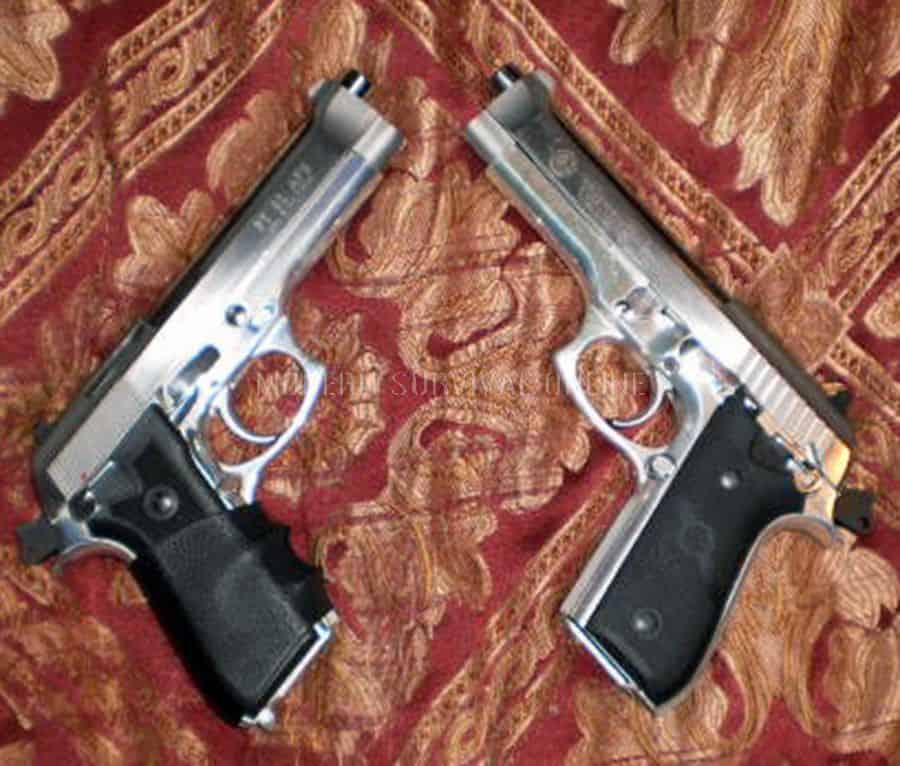
author’s pair of PT92s
I was nearly a victim of this when I was accosted by a carload of 4 people fitting that description in a dark parking lot late one cold winter night while I was in a phone booth (in the early ’90s cell phones were for the rich).
They pulled up to me and opened the doors of their 4 door car and so blocked me inside the booth. They were smiling as they got out of the car as if they were about to have some fun, (so they thought).
I’ve got something in my pocket for you
I smiled back as I went for my Star 30M 9mm pistol from inside my leather coat. The sight of a pistol coming from under my jacket was all it took to send them diving for their car and burning rubber as they drove off with much haste.
Only later did I learn just how lucky I/they were. The four matched perfectly pictures I saw on the news a couple of weeks later as being the perpetrators of senseless, violent, and apparently racially motivated attacks on lone, seemingly helpless white victims. As it turns out, this was apparently a gang initiation rite. They were all sent to prison for their crimes against their unarmed victims.
The hammer and the nail
While the mere sight of a handgun alone saved me from potential harm that night, it alone is not the tool of self defense. Just as a hammer cannot serve its purpose without nails, a handgun cannot serve its purpose without ammunition. And just like using the right nail for the job, you must use the right ammunition for the job. The job here is self defense, so use defense ammo.
FMJ (full metal jacket) ammunition while used by our military and other NATO militaries around the world is not the ideal ammunition for self-defense. This type of ammo is used by the military in order to be in compliance with the Hague Convention of 1899 which states in part:
“(IV,3): Declaration concerning the Prohibition of the Use of Bullets which can Easily Expand or Change their Form inside the Human Body such as Bullets with a Hard Covering which does not Completely Cover the Core, or containing Indentations”.
The last part of that statement is referring to soft point and hollow point ammunition, which are both illegal to use in war under this document.
So in other words no hollow points, soft points, or ballistic tips are allowed to be used in war. Although one particularly sneaky military (I won’t say Russia…but it’s Russia) uses FMJ hollow TIP ammunition. This is a completely enclosed FMJ projectile but the nose of the projectile has no lead.
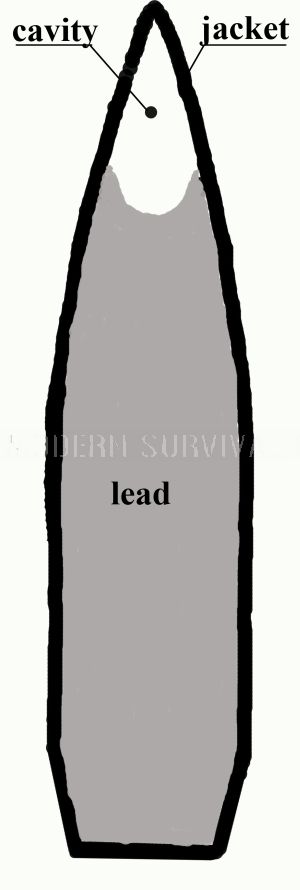 Hollow tip bullet
Hollow tip bullet
Yaw
This allows the projectile in effect to bend when it hits the body and therefore yaw (yaw means to rotate or flip) inside the body and so cause a much larger wound cavity as it passes through the body sideways.
This video explains this:
Wound the enemy, not kill them?
The reason for this is that, believe it or not, the intention in wartime is to wound and maim the enemy, not kill them. The pretense behind this ludicrous ideology is that it takes 2 soldiers to care for one injured soldier and so if you hit one you disable three.
It costs more money to care for wounded soldiers than to stick them in a bag, so it slows or cripples a government that way as well. That may be well and good for signers of the treaty but I didn’t sign it, did you?
I didn’t sign your treaty
FMJ ammunition is just fine for the target range, it’s plentiful and cheap. But if you ever need to stop an assailant, a blue helmeted shmoe, or any other domestic or foreign threat, the way this is achieved is by inducing rapid loss of blood pressure.
The hollow point
The best method of effecting a rapid loss of blood pressure is to use an expanding projectile, most commonly known as the hollow point, and placing accurate shots into the vital organ area of your target.
Examples of hollow point ammunition can be seen in the picture here:
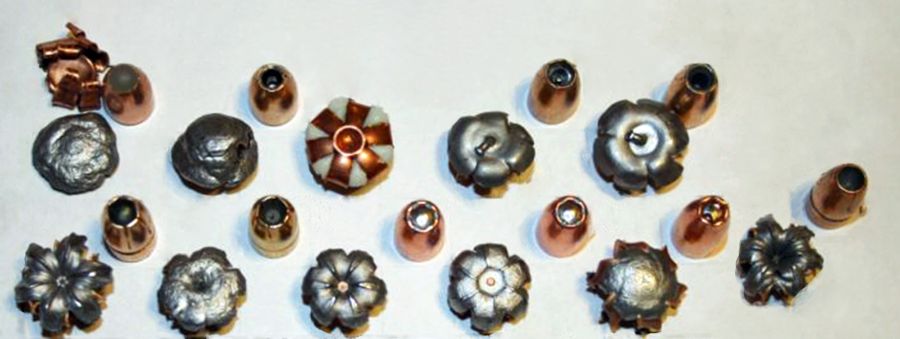
Notice the “mushroom” effect from the expansion of the projectile.
This expansion allows for more tissue damage, and the amount of tissue damage is what is known as the “crush factor”.
What is the crush factor?
When a projectile enters the human body, it strikes flesh and bone. A projectile of sufficient size and speed will shatter the bone, causing great damage. When the projectile passes through the soft flesh of muscles and organs, it creates a series of two wound cavities, the first is known as a temporary wound cavity, and the second is the permanent wound cavity. The permanent wound cavity is caused by the destruction of tissue. The amount of destroyed tissue is the crush factor of wound ballistics.
Don’t worry, it’s only temporary
The temporary wound cavity is the area of flesh that opens (a hole) that is created by the energy expended by the projectile. For the sake of simplicity, let’s say that mass X velocity = energy. Point being, a moving object will displace material, but the material will return to that space after the object passes. Just like when you run you push a hole through the air but the air returns behind you.
Temporary wound cavitation
Another, more visible example of this could be to think about if you punch into water. The water moves out of the way but comes back, that’s the temporary cavity. The temporary wound cavity from a handgun projectile may be 2 or 3 inches in diameter for a split second but then closes back for the most part after the bullet has passed.
For example, a 230gr (grain) bullet moving at 900 fps (feet per second) will create a larger temporary cavity than a 115gr bullet moving at 900 fps, but a 62gr bullet moving at 3200fps will create a larger temporary cavity than that 230gr bullet moving 900fps. See how that works? So the heavier and faster a bullet is the larger the temporary cavity.
Tissue damage
Part of tissue damage can be caused by the temporary cavity by the tearing of the tissue when it is stretched. This is unlikely to be caused by the amount of energy expended by handgun projectiles, but is a consideration with rifle projectiles. Although this torn tissue is damaged, it is still there and so is not relevant when considering crush factor.
Just for fun here’s a video of FMJ, SP, and, HP 7.62×39 ammo being tested:
Oops, that’s not going away
The permanent wound cavity is the hole that remains after the temporary cavity closes. This permanent wound cavity is left behind after the projectile passes through because the tissue is destroyed, or crushed. The amount of destroyed, or crushed tissue, is called the crush factor.
“Count” on it, or, don’t be afraid all I want is your blood…on the ground
The permanent cavity is the one that counts. I have performed my own ballistics testing, and I have read for uncounted hours on the subject, and there seems to be no lack of information on terminal wound ballistics.
Permanent wound cavity
The basics play out like this; when a projectile strikes flesh, the idea is to have as large of a hole left open as possible, that is the permanent wound cavity. This is necessary for the letting of blood, which then causes the loss of blood pressure that is needed to put down an aggressor.
Author’s Note: Most FMJ handgun projectiles don’t cause enough tissue damage to be effective defensive ammo as they tend to push the flesh aside, rather than destroy it as it passes through. This causes the permanent cavity to actually be smaller in diameter than the projectile, not the desired effect.
On the other hand, projectiles that expand significantly can often create a wound cavity that is larger in diameter than the projectile was before expansion, this is the ideal scenario.
Expand your mind, well, expand your bullet
For instance, a 9mm projectile being .355 inch in diameter can expand to sizes of 17mm or .65 inch in diameter, well over ½ inch and nearly double the original diameter. Some quality .40 cal and many.45 auto projectiles can expand up to .75 or .8 inch in diameter, that’s a ¾ of an inch hole or better!
Crush factor on tissue
The term crush factor tells the amount of tissue destroyed, in grams, caused by a projectile. It also describes the minimum amount of tissue damage necessary for stopping the average aggressor.
When an expanding projectile passes through the tissue, rather than the tissue merely being pushed aside, the tissue is destroyed to the point of nonexistence, leaving a channel where the tissue had been. This destroyed, or crushed tissue, is what the desired effect is. And the more tissue crushed the better.
I used these three calibers as my basis but there are a few revolvers that are more than sufficient for stopping a man. .38 spcl +P hollow points and .357 magnum hollow points leave very little for discussion after an aggressor has been hit squarely in the chest.
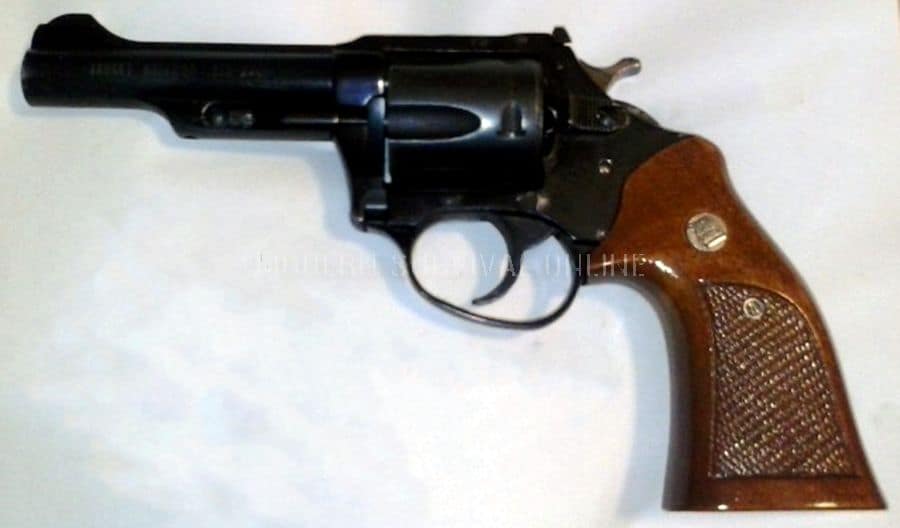
Author’s 85 dollar Charter Arms Bulldog 357
These six calibers, the 9mm, .40 S&W, .45 ACP, .38 spcl +P, the .357 magnum, and the .44 spcl are my personal favorite defense calibers, I feel, and ballistics show, that anything more is overkill, and anything less is not reliable.
Author’s note: A .380 or .32 cal pistol tucked away makes for a good backup gun and is better than a knife or a rock. It’s a given that one shot in the heart or brain stem, no matter the caliber, will kill, but I would not rely on the smaller caliber weapon as my primary defense weapon as they lack not only the penetration, but the mass and energy to cause an effective stopping wound with only one or two rounds.
Stopping power or no stopping power
I knew of a guy years ago that put a .380 in his mouth and pulled the trigger, the bullet lodged in his sinus cavity and gave him a really bad headache and a nastily bruised face for a couple of weeks. He had to have surgery to remove the bullet but he lived.
Yet another genius I worked with years ago shot himself point blank in his belly (says he was trying for his heart) with a .380 and all he got was a nasty scar to prove his love for the woman that drove him to this act of idiocy.
But thanks to these two guys I know firsthand that the .380 just lacks the stopping power. Don’t get me wrong, I don’t want to get shot with anything, but if an aggressor is high on crack or meth he is not going to be effected enough by these smaller rounds to stop him instantly. So if you have a .380 for your EDC gun I strongly suggest high quality expanding +P ammo (if your gun is rated for it) and shoot the aggressor until they stop or you run out of ammo.
Author’s note: Another thing to consider, and it’s an ugly truth but I always told my female instructees to keep it in mind, is if the potential victim is female and the bad guys intent isn’t robbery they may still begin what they planned even if they die before they finish, this is unacceptable. An aggressor ideally needs to be stopped in their tracks.
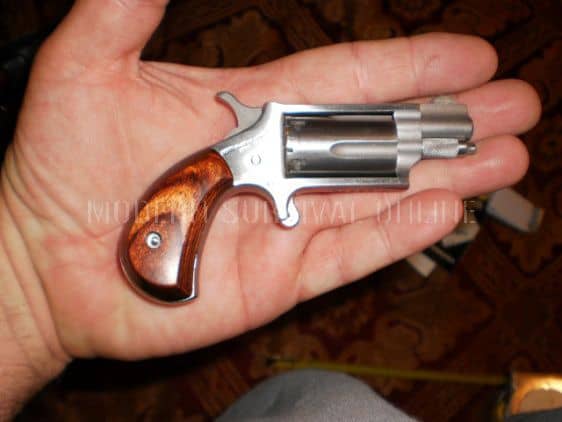
Author’s wood grip mini mag
I have seen people carry a .22 cal for self defense and this is just way too small to trust with your life (still better than a rock), although I have been known over the years to keep an NAA .22 magnum 5 shot mini revolver in my front pocket for just such an emergency.
Small calibers and crush factor
These smaller calibers require too many rounds on target to gain the crush factor of only one or two of the larger caliber rounds and in the heat of the moment it may be difficult to get one or two rounds on target, much less the eight or ten from a smaller caliber needed to achieve the same effect as the larger caliber.
Very long story short, carry a weapon with as much capacity as you can, and with sufficient power to stop with minimal shots, that’s why I prefer the .45 ACP. Use a high quality defense round, a dollar or two per shot is nothing when it comes to saving your life, and most importantly, you need to learn to use your weapon. After all, you can’t drive a nail if you keep hitting your thumb.
Stopping power
There is a ton of discussion over whether the.45 ACP is a better man stopper than the 9mm, others swear by the .40 cal. but the fact is that with modern expanding hollow points the 9mm will make nearly as big a hole as the .45 ACP and has a little more penetration.
Consider mag capacity
Then consider most 9mm handguns have a much higher mag capacity, and in the heat of the moment seven or eight rounds comes out awfully fast, with a 1911 .45 guess what? You just emptied your gun. But with most 9mm handguns you will still have anywhere from four to twelve rounds left. But now factor in a high capacity .45 (mine holds 13 rounds but I only carry 12 in it), and favor leans back to the .45.
The more the merrier
The same argument can be said for the .38 SPCL or .357 MAG, both very good weapons, as a matter of fact I carried a .38 snubby for nearly 15 yrs before I switched to a high capacity 9mm, The 9mm lasted for 5 years then I switched again to a .45.
But while these revolvers have great stopping power, you have only five, six, seven, or eight rounds before you are out. Also to be considered the 9mm actually has a higher muzzle pressure than the .38. I feel better knowing that my EDC weapon has eleven rounds in the mag and one in the tube. It actually holds thirteen, but I’m not going to carry thirteen rounds in my gun, I guess I’m superstitious.
My argument against the .40 caliber is that the payoff for a slightly larger caliber is outweighed by the higher cost and lower availability of the ammo, it just isn’t worth it, and so I’ll stick with my 9mm’s and .45’s.
Crushing blow
I have mentioned crush factor a few times in this article, let’s try to see just what exactly these most commonly carried calibers do to flesh. In order to stop an aggressor, you must crush 0.22 grams of tissue per pound of body weight of said attacker, thus a 200 pound attacker would need 44 grams of tissue crushed to effectively be stopped.
9mm
A 147gr HP 9mm projectile moving at 990 fps will penetrate approximately 15 inches deep and crush 43 grams of tissue. With approximately two thirds of this tissue damage effective for stopping, this means that the projectiles crush factor is 28 grams. In other words it takes two 9mm projectiles to cause 56 grams of tissue crush for an effective stopping wound. Thus unless directly hit in the heart or brainstem a 9mm may not stop with one shot, so double tap.
.45 ACP
Now let’s look at the .45 ACP, a 230 gr .45 ACP moving 875 fps will penetrate approximately 14 inches and crush 65 grams of tissue, approximately two thirds of this tissue damage, about 43 grams, effective for stopping. In other words, the .45 ACP may stop an attacker with one shot, if you hit them with a well placed shot. So again, double tap for good measure.
Really the long and short (get it, long and short? Like ammo? Yeah, ok,,,you’re right) Anyway, the long and short of the story is that if you carry a firearm intended to be used in the event of a situation in which you need to defend yourself you need to know how to use it.
Know how to use your EDC effectively
Practice, and by practice I don’t mean got to a range and stand still in a perfect triangle stance and shoot paper targets. I mean train. Drill, run and gun, practice drawing and double tapping your target, (discussed in previous article). It doesn’t matter if you have the most expensive pistol in the world, if you don’t know how to use it and/or you use crap ammo it’s going to be a sad day when the time comes.
Learn to fire under pressure
When you are target shooting you are relaxed and that target is far away and not trying to hurt you, it’s a big difference over the real world scenario that will cause you to draw your weapon. Keep in mind that one shot and down he goes, that’s on television. The reality is it’s going to take a few shots to put them down. So you need to learn to fire under pressure.
Mozambique drill
Then when you do get good at it and the situation arises to stop a bad guy, there is always the Mozambique drill, 2 in the chest, one in the head. This method is pretty much guaranteed to put them down and keep them down.
Final thought
After all is said and done, no matter what caliber you carry, none are effective if you can’t hit the target.
Get out and shoot.
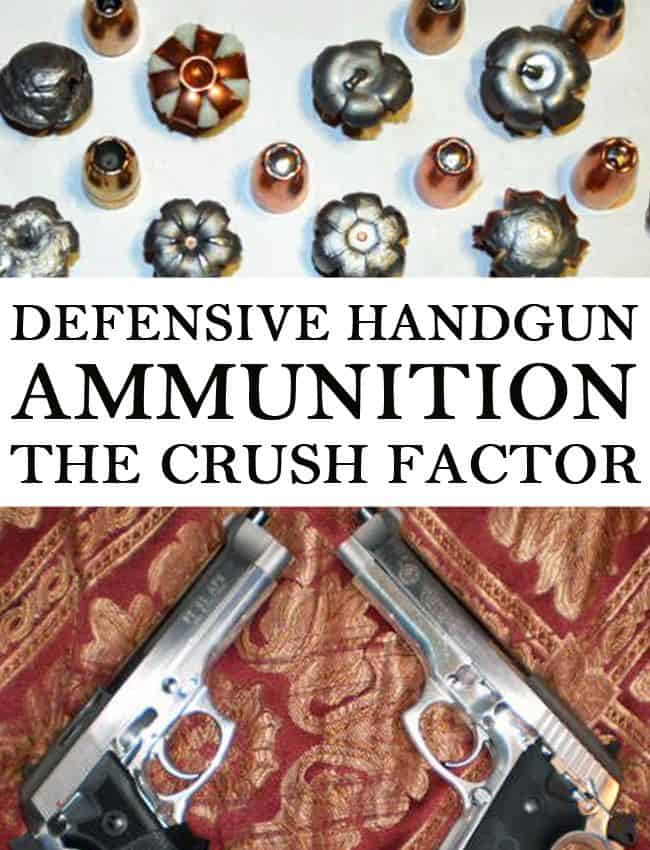

Like what you read?
Then you're gonna love my free PDF, 20 common survival items, 20 uncommon survival uses for each. That's 400 total uses for these dirt-cheap little items!
We will not spam you.
Dan and Eric, thank you for the article here. It’s a good reminder of something we assume but do not often think about in detail.
Because I must always use a scooter as the result of a combat injury, I must be certain that if I ever must “pull my smoke wagon,” I have to have everything thought out and ready. I use a GALCO Miami Classic shoulder rig for a RI .45 GI Compact or a SIG P226 in .40 S&W. Personally, the only time I’d be comfortable with a 9mm is if I had loaded it with +P+ hollow point rounds.
After all the smoke clears from the combat of weapon-and-caliber debate, I suppose the best ones are those that do the job. A vital aspect of this is analyzing your personal needs and restrictions while putting aside popularity, fads, and carrying your weapon because of what someone else does. Tailor your weapon to yourself and your need.
Again, thank you for a helpful article.
well put this aint hollyweird unless your a VERY good shot AND can handle extreme pressure very well most people cant hit spit under fire you made a very point about TRAINING THAT IS VITAL so use a old line THE MORE YOU GET BANGED UP IN TRAING THE LESS LIKEY YOU ARE TO WHENS ITS FOR REAL